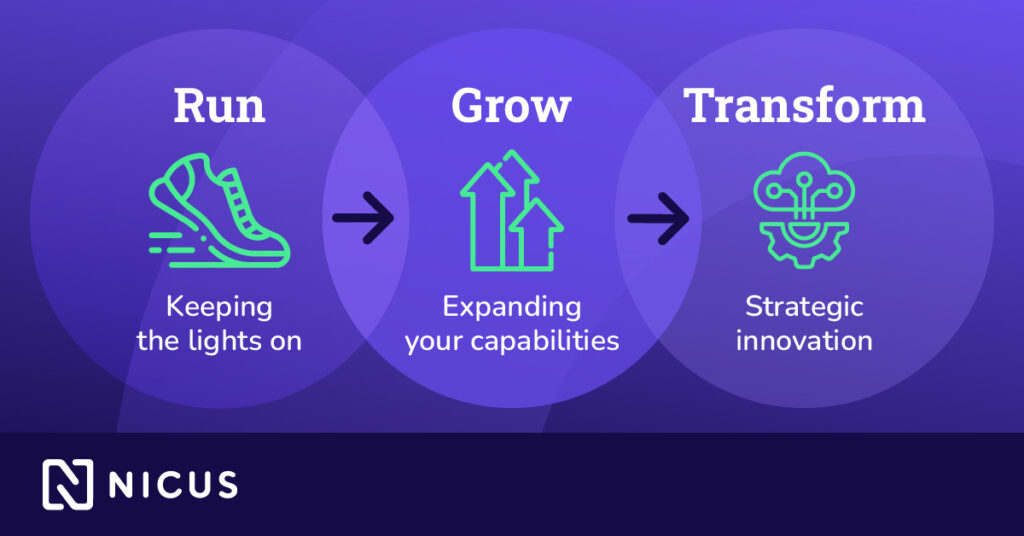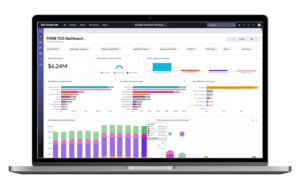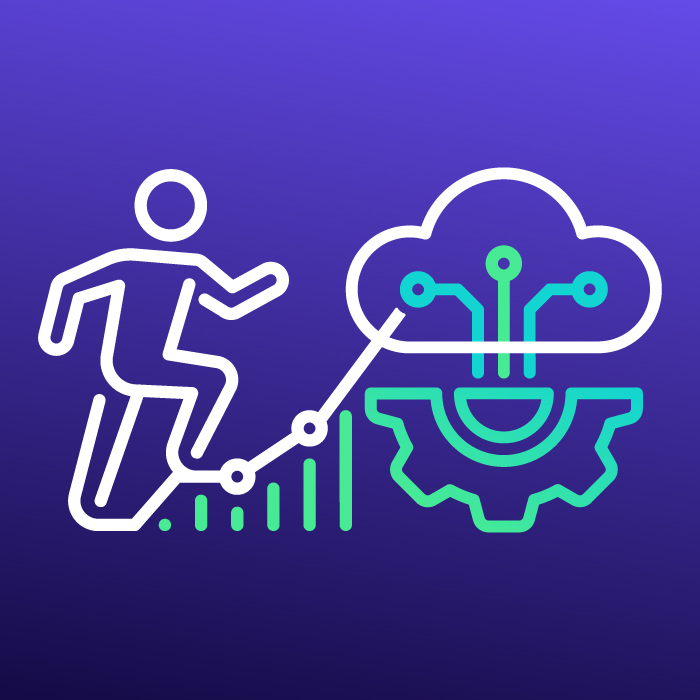What if your organization’s second largest cost was also your biggest blind spot?
This is the reality for many CFOs when it comes to IT spending, with millions of dollars flowing into IT without a clear line of sight into how those dollars support specific business strategies.
Gartner’s Run-Grow-Transform framework offers a compelling lens for assessing whether you’re investing in IT in the right way. But there’s a caveat: without robust IT financial management (ITFM) practices, the framework falls flat, and IT budgets get squeezed to the point of starving innovation.
With that in mind, let’s jump into how Run-Grow-Transform can help you align spending with enterprise strategy, plus the critical information and tools you’ll need to get it right.
Run-Grow-Transform: Connecting IT Spending with Strategic Priorities
In a world of shifting budgets and economic uncertainty, CFOs need to know:
- Are we spending money in the right places?
- How will that spending evolve over time?
- What levers can we pull to align spending more closely with business strategy?

That’s the power of Gartner’s Run-Grow-Transform framework, which breaks out IT spending into three categories:
- Run: Keeping the lights on
- Grow: Expanding your capabilities
- Transform: Strategic innovation
The idea is that you want a mix of investments that not only supports current IT operations, but also promotes innovation.
The Critical Gaps in Run-Grow-Transform Strategies Today
To fully leverage the Run/Grow/Transform framework, companies need to be able to do three things exceptionally well:
- Track what’s flowing into each bucket: If you aren’t capturing all of the costs that go towards supporting IT operations, which are spread all over the organization, you can’t effectively manage them to hit your targets.
- Predict how those flows will evolve over time: It’s vital to know not just what you’re spending today, but also what you’re spending tomorrow.
- Adjust the mix to align with business goals: You need the visibility into what levers you can pull and precisely how they will impact spending.
Most organizations fall short on all three, a problem that’s squeezing IT budgets today on a large scale.
Consider the following scenario: Let’s say you greenlight a $1M innovation project, without accounting for a $200,000 annual increase in run costs. If your IT budget must remain flat, over time this shifts a greater proportion of spend from transform to run, whittling down the dollars available for new projects.
IT ultimately becomes a drag on innovation rather than an enabler—a hole that can take years to dig out of.
Why ITFM is Critical to Visibility and Control
A robust ITFM program is essential to tracking, predicting and adjusting your mix of Run-Grow-Transform spending.
The reason is that corporate finance systems aren’t equipped to explain the complexity of IT spending, which is cross-functional, fluid and contains many indirect costs that standard tools can’t track at a meaningful level.
ITFM is what gives CFOs the tools to make the Run-Grow-Transform model actionable. Let’s look closer at why.
Tracking: What’s Actually In Your Buckets?
Corporate systems track what you’re spending, without connecting it to >why. >ITFM goes several layers deeper by:
- Mapping IT expenses directly to services, applications and capabilities
- Allocating shared costs like infrastructure and labor with precision
- Tracking unit costs over time to gauge efficiency as opposed to total spending
Predicting: What Are Your Downstream Costs and Hidden Risks?
ITFM prevents today’s innovations from becoming tomorrow’s budget bloat by allowing companies to model:
- Multi-year forecasts, including labor, cloud and application run costs
- The impact of tech debt on future run spending
- What-if scenarios that account for shifts in demand, headcount or vendor pricing
Adjusting: What Are Your Decision Levers and How Will They Impact Spending?
Broad budget cuts are a reactive approach to managing IT spending, and can have serious operational impacts. ITFM provides a strategic view into:
- Which services or applications can be consolidated
- What the tradeoffs are between different types of IT spending
- How to shift funds without undermining IT service delivery
Choosing the Right ITFM Tool
Traditional ITFM tools run into performance issues when it comes to enterprise-scale IT budgets with millions of lines of monthly transactions. As a result, these> tools rely on aggregated data, losing all of the operational detail essential to accurate spend tracking, forecasting and cost optimization.
ITFM software like Nicus is different in that it combines granular operational detail with finance-approved data from the financial book of record while using a decision-based cost model that aligns with how you deliver IT to the business. The result is more accurate, defensible insights into IT spending and the ability to optimize costs with a surgical level of precision.
If your company is serious about using the Run-Grow-Transform model to guide smarter investment, foster innovation and manage IT costs over time, ITFM is foundational to getting it right. Equally important is having ITFM tools that deliver both clarity and control, so whether you’re spending more or cutting costs, you know you’re doing it in the right places.
Free eBook: Learn about Corporate Planning vs. ITFM Tools and why the difference matters in enterprise IT spending







